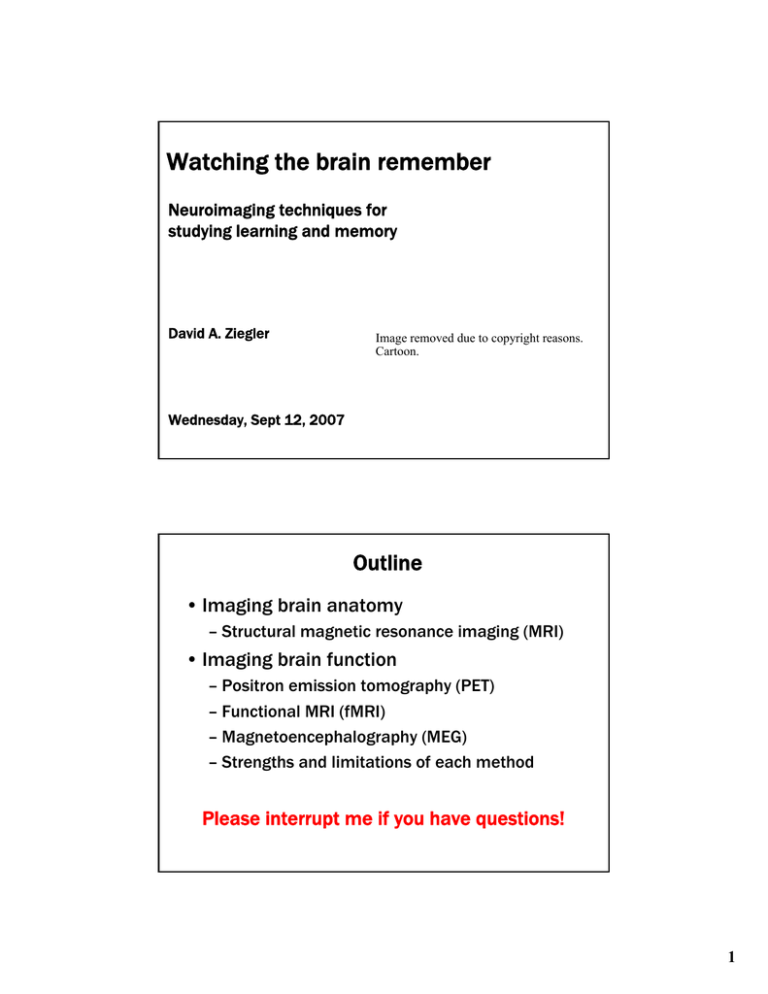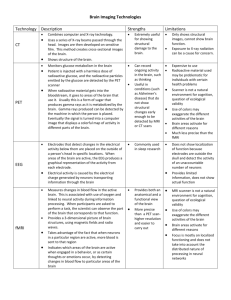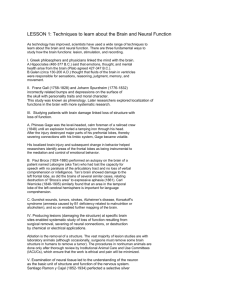Watching the brain remember Outline • Imaging brain anatomy • Imaging brain function
advertisement

Watching the brain remember Neuroimaging techniques for studying learning and memory David A. Ziegler Image removed due to copyright reasons. Cartoon. Wednesday, Sept 12, 2007 Outline • Imaging brain anatomy – Structural magnetic resonance imaging (MRI) • Imaging brain function – Positron emission tomography (PET) – Functional MRI (fMRI) – Magnetoencephalography (MEG) – Strengths and limitations of each method Please interrupt me if you have questions! 1 Functional neuroimaging techniques: spatial and temporal resolutions 1m Spatial resolution 10 cm Scalp ERPs Brain EEG Drug manipulations PET Human optical 1 cm 1 mm TMS fMRI Human intracranial ERPs Gyrus Lesion (human) Lesion (animal) Voxel(fMRI) Animal optical techniques Cortical column 100 µm Neuron Single-unit recording 10 µm Axon (diameter) 1 µm Patch-clamp recording Synapse 0.1 µm 1 ms 10 ms 100 ms 1s 1 min 1 hr 1 day 1 wk 1yr Temporal resolution Figure by MIT OpenCourseWare. Spatial resolution Images removed due to copyright restrictions. Three brain scan images of increasing resolution quality. 2 MRI then and now Images removed due to copyright restrictions. Photographs of original and modern MRI machines. First MRI of a human chest Images removed due to copyright restrictions. First MRI, of a human chest; photograph of man in first MRI machine; handwritten notes describing these results. 3 Basic modern MRI setup Illustration of human insertion into MRI machine. Figure removed due to copyright restrictions. • A superconducting magnet creates static magnetic field (B0) • B0 is aligned along head-toe axis • How do we generate images of the brain? Image removed due to copyright restrictions. Please see http://easymeasure.co.uk/principlesmri.aspx. 4 Images removed due to copyright restrictions. Please see http://easymeasure.co.uk/principlesmri.aspx. Low energy B0 High energy excitation pulse T1 relaxation time Based on Huettel et al. (2004) Radiofrequency excitation & relaxation time Energy state Low High Low B0 High excitation pulse Low High 5 Longitudinal T1 relaxation time: Following excitation, the amount of dephasing differs depending on the tissue type, leading to different T1 relaxation times Images removed due to copyright restrictions. MRI image with illustrative diagrams of white matter and CSF molecular dephasing activities. Figure from: Nitz, W.R., and P. Reimer. "Contrast Mechanisms in MR Imaging." Eur Radiol 9 (1999): 1032–1046. Typical T1 relaxation times at 1.5 Tesla: White matter = 787 ms Gray matter = 921 ms CSF = 2650 ms Nitz & Reimer (1999) Anatomical contrast Images removed due to copyright restrictions. MRI images of different brain slices, with contrast between the types of tissues highlighted. Huettel et al. (2004) 6 MRI of medial temporal lobe (MTL) structures Images removed due to copyright restrictions. de Toledo-Morrell et al (2003) Augustinack et al (2005) Structure versus function Image removed due to copyright restrictions. Mock MRI image of Homer Simpson's head, showing a very small brain surrounded by empty space inside the skull. Image removed due to copyright restrictions. Cartoon of Homer Simpson's head, with different "brain regions" outlined and labeled; for example, a large region is labeled "Sleep." fMRI for Dummies 7 Positron emission tomography (PET) Positron imaging invented at MIT/MGH in 1950s by Gordon Brownell Images removed due to copyright restrictions. Photographs of people undergoing PET scans. How PET works • Radioactive tracer coupled to biologically active molecule e.g., fluorine-18 + glucose (18FDG) • Tracers accumulate in active cells • Radioisotopes decay, emitting positrons Coincidence detectors Images removed due to copyright restrictions. Illustration of radioactive fluorine decay and PET scan setup. 8 An early PET study of memory encoding • Participants were scanned while they studied lists of words Images removed due to copyright restrictions. Rough diagram of areas of activation in the brain during shallow and deep encoding. • Compared oxygen-15 uptake during shallow versus deep encoding • Deeper encoding led to significantly greater subsequent recognition – Consistent with the “level of processing effect” (Craik & Lockhart, 1972) • Deep encoding resulted in increased blood flow to left prefrontal cortex – One of the first studies to show activity of PFC during memory encoding Kapur et al (1994) – Compare these results to Figure 3.4 in your text (i.e., an fMRI study by Lila Davachi) Strengths and limits of PET High degree of specificity – Glucose metabolism – Blood flow – Neurotransmitters Image removed due to copyright restrictions. PET scans of a brain. Limitations – Radiation exposure is risky (FDA regulation: only one scan per 6 mo period) – Relatively low spatial (≥ 5mm) & temporal (≥ 5sec) resolution – Long acquisition times – Costly and inconvenient 9 The rise of fMRI Why has fMRI largely replaced PET in cognitive neuroscience? – Cheaper • No radioactive tracers Æ no need for an on-site cyclotron – Safer • No need to inject radioactive tracers • Can be repeated without side-effects – – – – Better temporal (~2sec) & spatial (2-5 mm) resolution Faster acquisitions Readily available to researchers Simultaneous whole brain coverage • Good for identifying of large-scale, distributed neural networks So, how do we measure brain activity with MRI? Sending blood to neurons Artery Oxyhemoglobin is diamagnetic Dc = 0 ppm Vein Deoxyhemoglobin is paramagnetic Dc = 0.08 ppm Magnetic susceptibility Spin dephasing & signal loss Courtesy of Ravi S. Menon. Used with permission. Animation courtesy of Ravi S. Menon Robarts Research Institute, University of Western Ontario 10 Sending blood to neurons Artery Vein Courtesy of Ravi S. Menon. Used with permission. The rise of oxygenated blood in veins leads to increased signal on MRI: Blood Oxygenation Level Dependent (BOLD) signal Animation courtesy of Ravi S. Menon Robarts Research Institute, University of Western Ontario Recap: what does fMRI really measure? • When neurons in the brain are firing, blood flow to that area increases (Roy & Sherrington, 1890) • The increased blood flow brings more oxyhemoglobin to that area • The inflow of oxyhemoglobin increases more than the increase in oxygen consumption Æ increased ratio of oxy-to-deoxyhemoglobin in veins • The relative decrease in venous deoxyhemoglobin makes the magnetic field more homogeneous • Because deoxyhemoglobin is paramagnetic and causes magnetic susceptibility, spin dephasing, & signal loss (T2*) • When the magnetic field becomes more homogeneous, the MR signal increases in intensity • This is Blood-Oxygen-Level-Dependent (BOLD) contrast 11 First BOLD experiment in humans (at MGH!) Images removed due to copyright restrictions. OFF ON OFF ON Kwong et al., 1992 Courtesy of National Academy of Sciences, U. S. A. Used with permission. Source: Kwong, K. K., et al. "Dynamic Magnetic Resonance Imaging of Human Brain Activity During Primary Sensory Stimulation." PNAS 89 (1992): 5675-5679. Copyright 1992 National Academy of Sciences, U.S.A. Experimental designs Block design Event-related design Image removed due to copyright restrictions. Please see Fig. 3 in Matthews, P. M. and P. Jezzard. "Functional Magnetic Resonance Imaging." Journal of Neurology Neurosurgery and Psychiatry 75 (2004): 6-12. Rapid event-related design Image removed due to copyright restrictions. Based on Huettel et al (2004) 12 Subsequent memory paradigm Subsequently remembered Subsequently forgotten ] Study: W1 W2 Test: Remembered: W1 & W3 W3 fRMI signal intensity W4 Forgotten: W2 & W4 Figure by MIT OpenCourseWare. • Encoding trials are sorted post hoc based on which items are actually remembered in a recognition test • Powerful approach to examine encoding processes (e.g., Wagner et al., 1998 – student presentation) Common criticisms of fMRI • Limited temporal resolution • Limited spatial resolution – Higher field strengths, better surface coils, & innovative statistics are improving both temporal and spatial resolution • Only provides an indirect measure of neuronal activity – but the BOLD response IS correlated with neuronal activity • Does increased activation = localization of function? – Complex cognitive tasks activate multiple cortical areas – fMRI is unable to establish the necessity of a given region – Other methods are still needed to infer causality (e.g., lesion, drug, or genetic studies) – Together, these complementary data are likely to yield far more interesting and meaningful conclusions 13 Getting closer to neural activity All electrical currents generate a surrounding magnetic field Courtesy of Michael Weisend. Used with permission. Image removed due to copyright restrictions. Model hand displaying the "right-hand rule." This includes neurons! http://uuhsc.utah.edu/uumsi Magnetoencephalography (MEG) basics If enough brain cells are active at the same time, the generated magnetic field can be measured with special sensors Images removed due to copyright restrictions. Diagram of electrodes picking up magnetic brain waves and MEG setup; figures from Hämäläinen, Matti, et al. "Magnetoencephalography-theory, Instrumentation, and Applications to Noninvasive Studies of the Working Human Brain." Reviews of Modern Physics 65 (1993): 413-497. Hamalainen et al 1993 14 Magnetic isofield & timecourse map Courtesy of Michael Weisend. Used with permission. http://uuhsc.utah.edu/uumsi MEG study of encoding/retrieval • Encoding: participants studied 240 real-life photographs – ½ buildings, ½ landscapes – Instructed to make building/landscape judgment • Retrieval: 240 original stimuli intermixed with 240 new stimuli – Instructed to make “old”/”new” judgments • Brain activity recorded using whole-head MEG • Looked for differences in oscillatory, or rhythmic, neural activity during encoding (i.e., subsequent memory paradigm) and during retrieval (old/new effect) • Common neural rhythms: Theta (4-12 Hz), Alpha (5-15 Hz), Beta (20-30 Hz), and Gamma (35+ Hz) Osipova et al (2006) Courtesy of the Society for Neuroscience. Used with permission. Source: Figures 1, 2, & 4 from Osipova, Daria, et al. "Theta and Gamma Oscillations Predict Encoding and Retrieval of Declarative Memory." The Journal of Neuroscience 26 (2006): 7523-7531. 15 Subsequent memory effect: gamma activity During encoding, gamma activity was greater in visual cortex for items later remembered compared to forgotten items Source of gamma localized to occipital lobe (BA 18/19) Osipova et al (2006) Courtesy of the Society for Neuroscience. Used with permission. Source: Figures 1, 2, & 4 from Osipova, Daria, et al. "Theta and Gamma Oscillations Predict Encoding and Retrieval of Declarative Memory." The Journal of Neuroscience 26 (2006): 7523-7531. Gamma activity during retrieval Gamma power was greater in visual cortex for remembered items compared to correctly rejected new items Source of gamma localized to occipital lobe (BA 18/19) Osipova et al (2006) 16 Putative role of gamma in LTM • Gamma oscillations in visual areas during encoding may result in increased synaptic drive in downstream association areas – May facilitate plasticity – In rats, LTP can be induced by phase locking stimulus presentation with hippocampal theta rhythms • Gamma activity during retrieval may reflect reactivation of visual representations – Likely via top-down, cognitive control mechanisms Tradeoffs in functional neuroimaging • High specificity (e.g., glucose, neurotransmitters) PET – May be useful for clinical purposes • Specificity comes at a safety cost (radioactivity) • Spatial and temporal resolution are relatively poor • Only an indirect measure of neural activity – BOLD contrast is actually caused by an increase in oxyhemoglobin fMRI • Relatively good spatial and temporal resolution • Allows for simultaneous whole-brain coverage – Well suited for studying networks • No known health risks (good for longitudinal studies) MEG • Very high temporal resolution • Relatively direct measure of neural activity (magnetic fields) • Not good for measuring subcortical activity • Can be difficult to model sources of neural activity – Relies on complex model that may turn out to be incorrect 17






